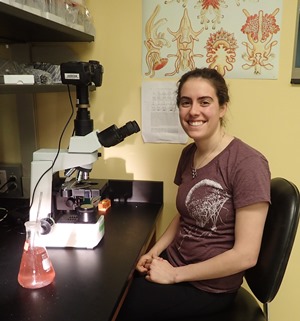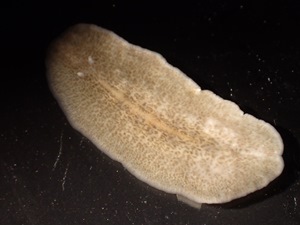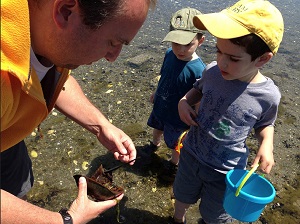Sigma Xi Funds Foster Research Legacy
In January of 2016, Anna Klompen W&M '17, was awarded a Grant-in-Aid of Research from Sigma Xi, The Scientific Research Society. Sigma Xi, founded in 1886, is one of the oldest scientific research organizations in the world and counts more than 200 Nobel Laureates as current or past members. Anna is the first W&M undergraduate to receive this grant in more than 10 years. What follows is an account of why this award carries weight not only for Anna, but also for Jon Allen, her undergraduate research advisor, who reflects on how this award became a springboard for his own career. - Editor

When I was an undergraduate student, and an admittedly mediocre performer in the classroom, I had the great luck to land a summer fellowship collecting fossilized marine invertebrates in the badlands of Montana. This summer research experience, an increasingly common feature of undergraduate education, was the springboard that propelled me into graduate school and eventually the position I hold now as a faculty member at William and Mary. A more short-term benefit of that summer research experience was that my undergraduate advisor nominated me for membership in Sigma Xi, the scientific research society. It was the first real academic honor I ever received and it bolstered my self confidence as I headed off to graduate school.
In my second year in graduate school I received my first grant through Sigma Xi's Grants-in-Aid of Research program. The funding was for a modest amount, but it allowed me to purchase much-needed supplies for my research and also provided me with another shot of self-confidence, a reagent that can be the limiting step in the complex chemical reactions leading to completion of a Ph.D. To this day, I still list the award on my CV.
Fast forward to the present day, I now run an active research lab at William and Mary full of outstanding undergraduates. This winter, one of those undergraduates, Anna Klompen (WM '17) applied for and received a Sigma Xi Grant-in-Aid of Research (GIAR) award as only a junior. Competition for the awards is keen, with only 15 percent of proposals receiving funding and most of those going to graduate students. As evidence of this, nine graduate students from William and Mary have received funding from Sigma Xi over the past 15 years; but Anna is only the second W&M undergraduate to receive support since 2003.
 Anna's project is titled 'Effects of current and historic food availability on the development of Stylochus ellipticus in the Chesapeake Bay' and takes advantage of newly-developed techniques for rearing flatworm larvae in the laboratory. It turns out that flatworms like Stylochus ellipticus love to eat newly-settled oysters and Anna's project will investigate whether the environmental conditions in the Bay are currently more favorable to their growth and development than they have historically been. If, as she predicts, current conditions are more favorable, then this will inform scientists and aquaculturists working to restore oysters to the Bay where their distribution overlaps with these predatory flatworms.
Anna's project is titled 'Effects of current and historic food availability on the development of Stylochus ellipticus in the Chesapeake Bay' and takes advantage of newly-developed techniques for rearing flatworm larvae in the laboratory. It turns out that flatworms like Stylochus ellipticus love to eat newly-settled oysters and Anna's project will investigate whether the environmental conditions in the Bay are currently more favorable to their growth and development than they have historically been. If, as she predicts, current conditions are more favorable, then this will inform scientists and aquaculturists working to restore oysters to the Bay where their distribution overlaps with these predatory flatworms.
The funding Anna received from Sigma Xi will help her to collect and rear the animals that she needs for her work. More importantly, the recognition of her work by a panel of senior scientists has elevated Anna's goals for her future research to even greater heights.
During a recent story on the Sigma Xi website, Dr. Peter Harries, the Chair of the Committee on Grants-in-Aid of Research, wrote how meaningful the GIAR program was to him as a graduate student studying mass extinction events in the Rocky Mountains. Little did Harries know that one of the awardees this year (Anna) would be a student whose research advisor (me) was himself an undergraduate assistant many years before, collecting fossils in those same outcrops in the mountains. I can still recall one collecting trip with a young assistant professor in the badlands named Dr. Peter Harries, bounding through the fields with a small child on his back calling out the name of our quarry 'Rhaeboceras....Rhae, Rhae, Rhaeboceras!'.
 Now, as I walk through tide pools with students and my own small children in tow, I remind myself that while careers in science can be challenging and hard to maintain, even small gestures of support and moments of recognition by your peers and colleagues sustain you and build your confidence in your own abilities. It's my hope this is the first of many such moments for Anna and the rest of the students who received award notices this spring.
Now, as I walk through tide pools with students and my own small children in tow, I remind myself that while careers in science can be challenging and hard to maintain, even small gestures of support and moments of recognition by your peers and colleagues sustain you and build your confidence in your own abilities. It's my hope this is the first of many such moments for Anna and the rest of the students who received award notices this spring.
 Skip to main content
Skip to main content
